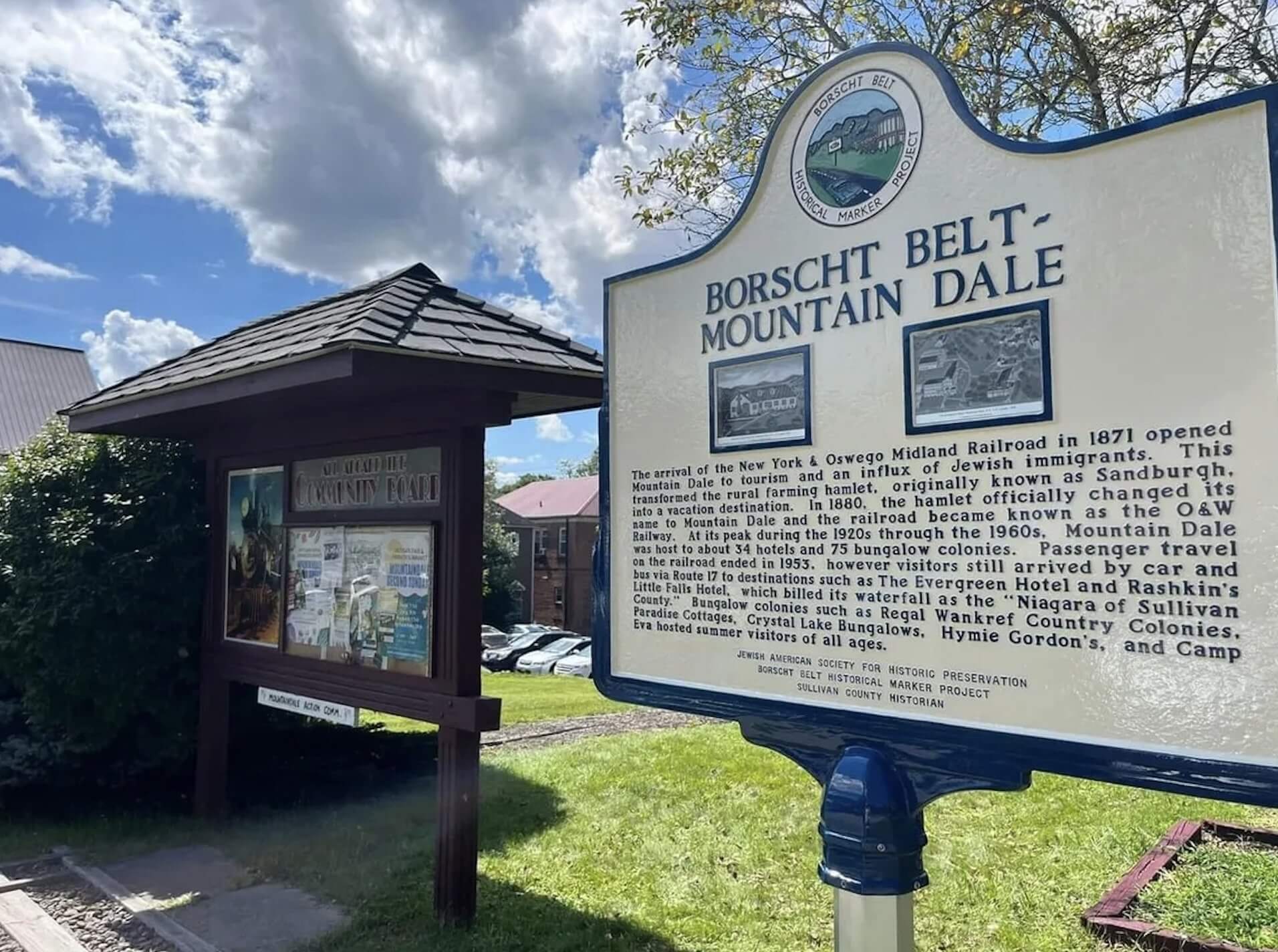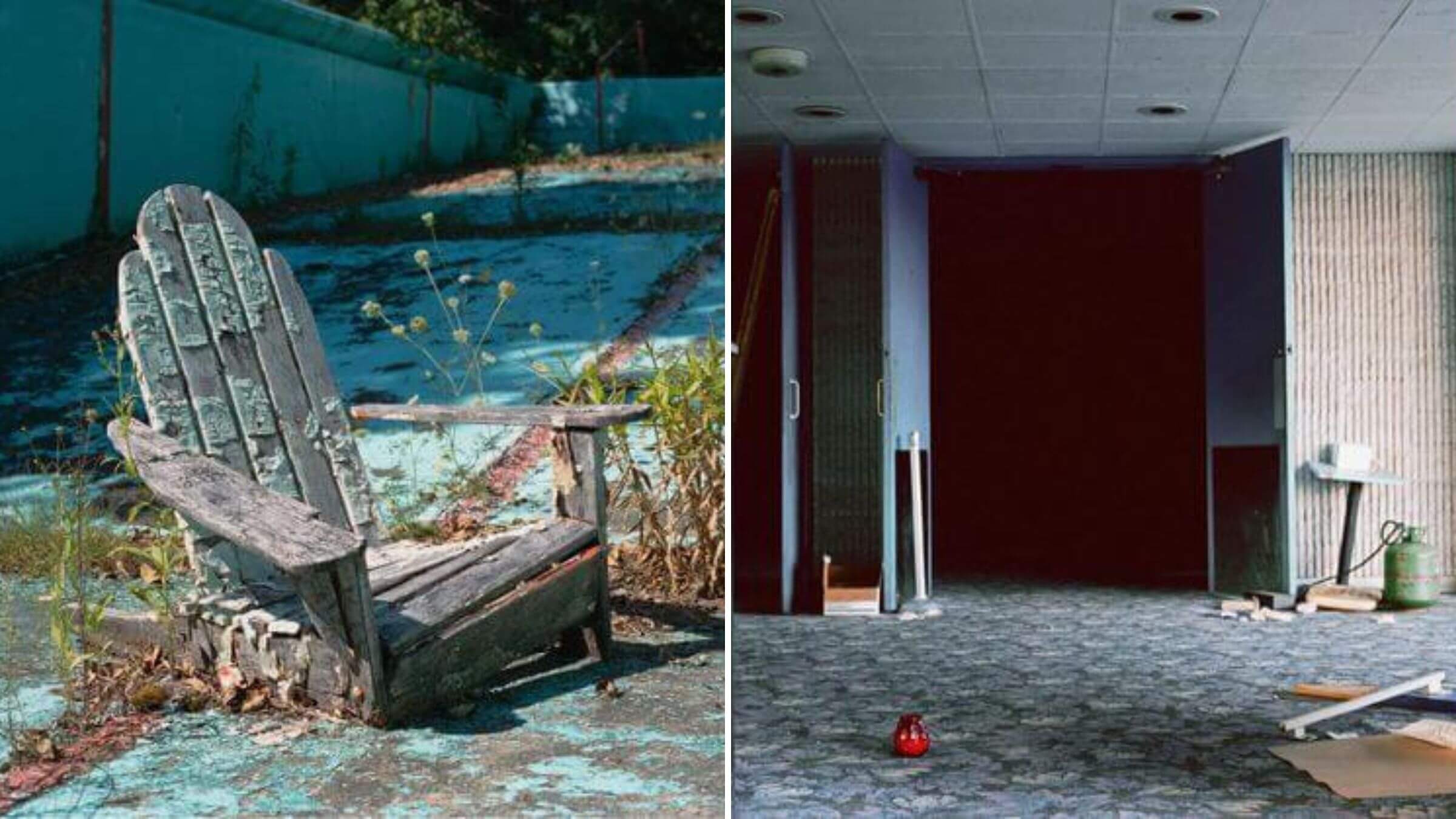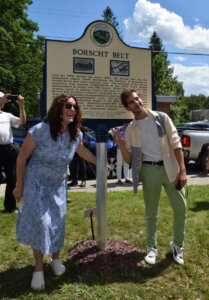The Borscht Belt resorts were abandoned long ago. But these signs point to a brighter future
A new trail of historical markers pays tribute to a Jewish vacation hub — and could spur Catskills tourism

Graphic by Angelie Zaslavsky
The town of Mountain Dale, New York, once boasted 34 hotels and 75 bungalow colonies. Famous comedians, musicians and athletes played charity games and gave concerts for the Jewish tourists who swelled the town’s population each summer. On summer nights, when the shows ended and the bars closed, weekend revelers flocked to Pop-ins, a restaurant in nearby South Fallsburg owned by Alice Manzi’s family.
Grossinger’s is gone, but this marker trail lets a new generation tour the Borscht Belt.
“People came in at one, two, three in the morning,” Manzi, now 79, recalled. “I had friends I never would have met if we didn’t have this beautiful place. It was a great childhood.”
These days, Pop-ins is no more. The resorts that provided the restaurant’s customers have been closed or abandoned, their empty shells overgrown with grass and splashed with graffiti. I met Manzi in a modest park near Mountain Dale’s now-sleepy Main Street. We were both there to attend the dedication of a historical marker documenting Mountain Dale’s role in the Borscht Belt, a network of resorts and businesses that made the region a hotspot for Jewish vacationers in the mid-20th century.
The eclectic group gathered at the park included patient seniors, local business owners, and visitors in Instagram-chic sundresses. Everyone seemed to be in the process of recognizing an old friend. The buff proprietor of a boutique called Bad Grandma shook my hand while a beige sheet fluttered ominously over the soon-to-be-unveiled marker. The second in a series of 21 markers to be placed at sites of Borscht Belt significance, the Mountain Dale plaque is the town’s first official tribute to its Jewish past. It’s part of a larger effort to document and memorialize a phenomenon that shaped the region’s history — and, proponents say, could secure its future.
“As we move into the future, and the Borscht Belt is further behind us, the markers will be a permanent map of our history,” said Marisa Scheinfeld, the founder and director of the Borscht Belt Marker Project.
‘Erased from the landscape’
The winding state highway leading toward Mountain Dale features billboards for Hasidic organizations targeting ultra-Orthodox vacationers and advertisements for opioid rehabilitation programs reflecting the area’s modern crises. Tucked in the foothills of the Catskill Mountains, the town marks the center of the erstwhile Borscht Belt, which peaked in the 1950s, when many American Jews were prosperous enough to indulge in leisure activities yet still excluded from many mainstream vacation establishments.
Mostly concentrated in Sullivan and Ulster counties, Borscht Belt resorts launched the careers of comedians like Lenny Bruce and Joan Rivers, dominated the regional economy, and shaped the rhythm of life for locals who grew up valeting cars for tourists and spotting celebrities at the resorts. But in the later part of the 20th century, as antisemitic discrimination eased and airplane travel became cheaper, the Borscht Belt’s resorts shuttered one by one.
Scheinfeld, whose grandparents vacationed in the Borscht Belt for decades, grew up witnessing that decline. When her parents moved their family from Brooklyn to the Catskills in the 1980s, local tourism had withered. With land plummeting in value and no other industry emerging to drive the economy, many resort owners were unable to sell their properties and abandoned them instead. Once a hub of Jewish leisure, Sullivan County became notable for the eerie spectacle of those deserted properties.
Now a photographer and occasional contributor to the Forward, Scheinfeld has spent years documenting the Borscht Belt’s decay. Her 2016 photobook, The Borscht Belt, compiled stills of decrepit dining rooms, overgrown pools, and rotting Adirondack chairs.

In 2021, Scheinfeld secured funding for a series of markers like the one in Mountain Dale from the Jewish American Society for Historic Preservation, a nonprofit that funds memorials at historic sites throughout the United States. (Each marker costs a little over $4,000 to fabricate and install.)
Two years later, as the first markers go up, Scheinfeld has assembled a team of Catskills historians and Borscht Belt enthusiasts who evangelize the region’s history in the parlance of a younger, extremely online generation. The markers will eventually be linked by a driving route and self-guided audio tour. On Instagram, the project cultivates a hip, artsy palette by sharing grainy video footage, campy postcards, and vintage candids.
Composing the actual text of the markers requires less digital literacy than firsthand Borscht Belt experience. Sullivan County Historian John Conway, who grew up in nearby Rock Hill and spent his summers playing ball at the bungalow colonies, fact-checks each marker against local archives and his own memory. In over three decades as county historian, he’s seen multiple upticks of interest in Borscht Belt history, but the last few years have marked the biggest surge in his tenure; in addition to the markers project, a Borscht Belt museum is in the works in nearby Ellenville.
Conway attributed this attention in part to The Marvelous Mrs. Maisel, which features a significant Borscht Belt plotline. He also theorized that millennials who grew up hearing about their grandparents’ Borscht Belt escapades are finally old enough to investigate that history themselves. With few public educational resources available, it’s easy for inaccurate information to circulate.
“I look at this project as something that can keep everybody on the right track and make sure that the information out there is correct,” Conway said.
A rural renaissance
Driving into Mountain Dale was kind of like stepping onto the bucolic small-town set of Gilmore Girls, except that almost everyone was Jewish and half the buildings were abandoned. In the windows of an empty storefront that was once a Jewish grocery, a series of vintage signs advertised schmaltz herring for 29 cents and kosher dill pickles for 51.
Today, the town’s small commercial strip is anchored by Forage and Gather, an upscale market and cafe. When I arrived, customers were busy foraging for paleo-compliant chocolate chips and gathering cans of grapefruit kombucha. (Both cost considerably more than 29 cents.)
In honor of the marker dedication, Forage and Gather had put borscht on the menu. Historic fare was also available in the shady yard of the town’s defunct elementary school, where a local artisan market offered lavender products and tarot readings and a pop-up restaurant called Ashkenosh served knishes and celery granitas.
I bought a giant pickle and wandered the perimeter of the school, listening as a woman pointed out her former classroom to a friend. Everyone I talked to seemed to be a close friend of Scheinfeld’s. (She later told me that her high school English teacher was in attendance.) Golden retrievers were too numerous to count.

As the time for the unveiling neared, Scheinfeld shushed the crowd in the park and ended my interview with Manzi. Isaac Jeffreys, a fellow Borscht Belt photographer who runs social media for the markers project, officially unveiled the marker, which gives readers a 140-word crash course in Mountain Dale’s century-long history. Local officials gave short speeches, as did a lifetime Mountain Dale resident who informed the crowd right away that she would not be adhering to the three-minute time limit.
“The purpose of what happened here was really about exclusionary behavior,” said Fallsburg Deputy Supervisor Sean Wall-Carty, referring to the discriminatory practices that once barred Jews from most hotels. “We hope that this marker will inspire people to become more inclusive, to look around our community and see where we have deficiencies.”
Locals are already anticipating how new interest in Borscht Belt history — and the creation of modern attractions — could boost the tourist economy. After the dedication, attendees trooped to a small gallery on the town’s main street displaying photographs by Scheinfeld and Jeffreys. Alice Manzi’s daughter, Dara, was breaking up ice and serving wine from a makeshift bar on the window sill. After several years living in New Orleans, Dara returned to her Catskills hometown during the pandemic and now runs a transportation and bus tour service with the motto “Ride the D” (“It’s a double entendre”). As more markers go up, she intends to start offering Borscht Belt-themed tours, which she hopes could be a lifeline to local businesses.
“They’re gonna have to eat, they’re gonna have to drink, they’re gonna have to sleep somewhere,” she said of prospective tourists.

Spikes of interest in rural development can come with costs; and gentrification is already a problem in the Catskills. Sullivan County has the highest rate of opioid related deaths in New York, and 21% of its children live under the poverty line, according to data from 2022. But a wave of pandemic-era transplants caused the median sales prices for single-family homes to rise 35% in 2021, Curbed reported. Elsewhere in the Catskills, the rental market has tightened so much that businesses have had to subsidize housing for their workers.
“There are plusses and minuses,” said Ira Steingart, a Sullivan County legislator, referring to the increase in tourism. Steingart’s ties to the region extend back four generations, when his great-grandfather started a commercial printing company that created menus, brochures, and signage for Borscht Belt businesses. Steingart said that in the past three years, the county’s revenue from sales taxes increased from $35 million to $65 million, an infusion of money into the community that he described as a positive change.
For Scheinfeld, new development makes the markers project even more urgent. In the years since her book debuted, many of the abandoned resorts she photographed have been replaced by new buildings. “With each year passing, remnants are further erased from the landscape,” she said. “As are the people who lived and worked in it.”

One day, she hopes that the markers project will serve as a resource for local schools and help students connect with their Catskills history. In the meantime, she’s acting as that resource herself.
As visitors milled about the gallery, a man approached Scheinfeld and introduced himself. He had a photo of a postcard depicting a small hotel that his grandparents once owned, but he couldn’t locate it in any lists of Borscht Belt establishments. Scheinfeld immediately started ticking off databases to check and people to consult.
In the days since the dedication, she said, she’s received a “swarm” of texts and emails from others who want to research their Borscht Belt connections.
“It really does feel like we’re being recognized,” she said.























